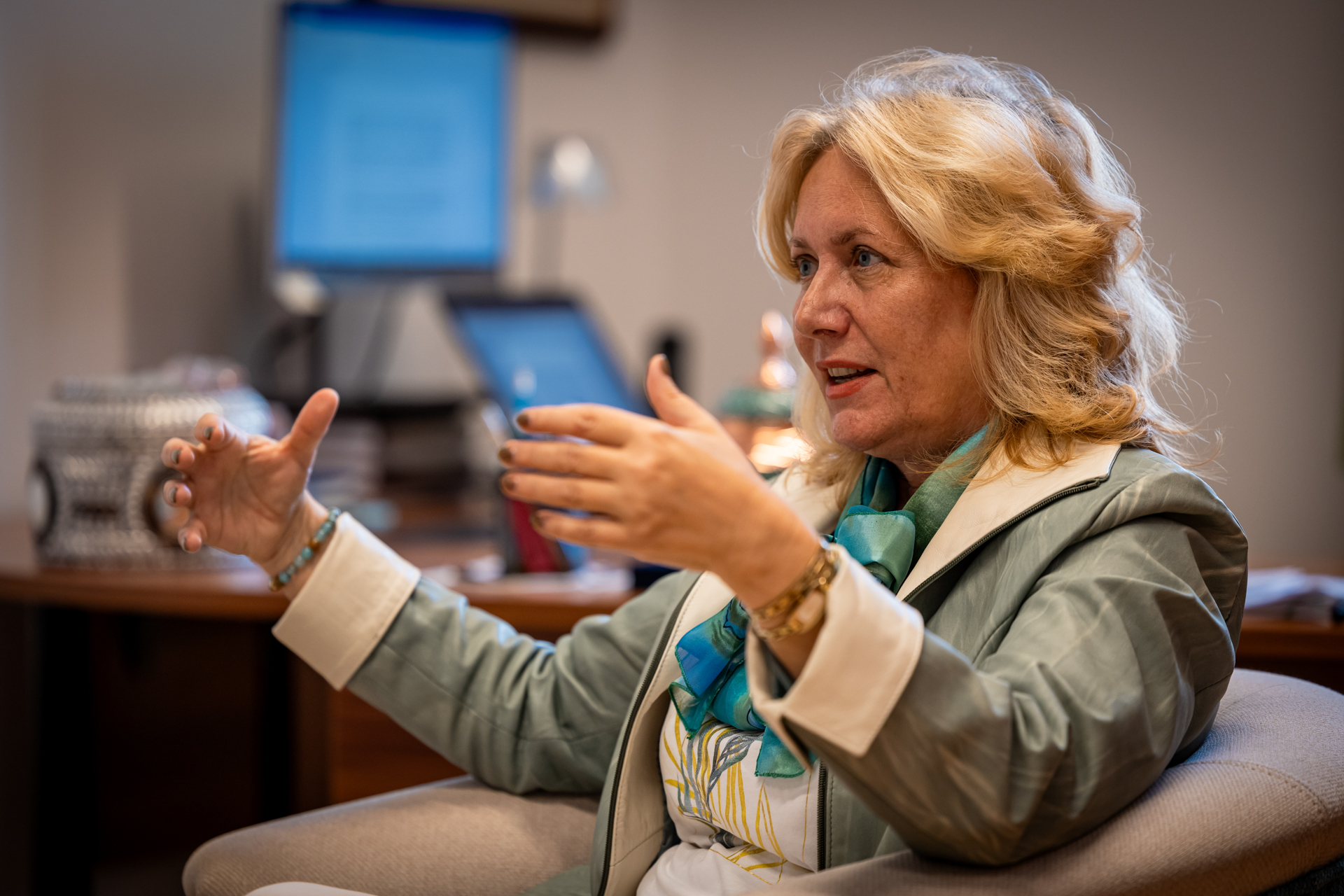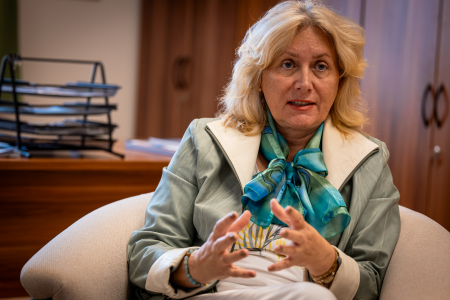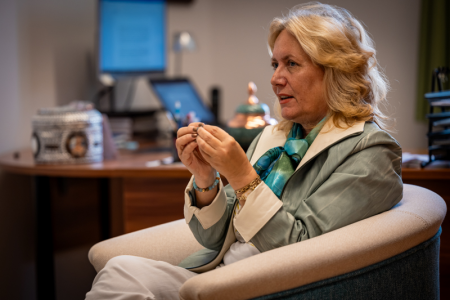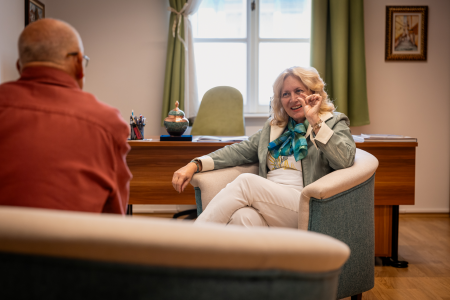

Prof. Dr. Márta Széll: Katalin Karikó's Nobel Prize is deeply connected to the history of the University of Szeged
Referring Kuno Klebelsberg in relation to Katalin Karikó's Nobel Prize is more than a historical artifact of the University. According to Prof. Dr. Márta Széll, Vice-Rector for Strategic Planning at the University of Szeged, due to the network-like character of research, a clear scientific history can be traced between the major biochemical research laboratories at the University of Szeged and the new Nobel Prize.
– When Katalin Karikó's Nobel Prize was announced, amidst general joy, you stated that this recognition indeed fits into the history of biochemical research initiated at the University of Szeged following Kuno Klebelsberg's vision: could you please explain how?
– In the late 1920s, shortly after the relocation of the University of Kolozsvár (Cluj-Napoca) to Szeged, Kuno Klebelsberg initiated the establishment of a world-class biochemical and life sciences research centre. He called Albert Szent-Györgyi back to Hungary to establish this institution, and within ten years, the vision proved itself: in 1937, Szent-Györgyi received the Nobel Prize for "discoveries in the area of biological combustion processes, particularly in regard to vitamin C, and the fumaric acid catalysis". The impact of the Nobel Prize and Szent-Györgyi extended out much further, as it led to the establishment of research schools that developed and became of extraordinary significance on their own. One of these schools was marked by the research direction associated with Brunó F. Straub and Ilona Banga, which led to the breakthrough discovery of actin through the study of muscle function. The discovery, isolation and first description of this molecule is also associated with the University of Szeged. Both Brunó F. Straub and Ilona Banga were students of Albert Szent-Györgyi, and were employed by himself. Beside these think tanks, further schools of life sciences were established at the University of Szeged, such as the one of Dr. Miklós Jancsó Jr., who studied inflammations of neural origin and the inflammation mechanisms of sensory nerve endings. He was the first to describe the sensory neuron blocking effect of capsaicin. It is a unique co-incidence that Albert Szent-Györgyi extracted vitamin C from Szeged paprika Dr. Miklós Jancsó Jr. also used capsaicin extracted from paprika for his research. In 2021, the Nobel Prize in Physiology or Medicine was awarded to David Julius and Ardem Patapoutian for identifying the capsaicin receptor, their discovery was also built upon the recognitions of Dr. Miklós Jancsó Jr. and his research group.

Photo: Prof. Dr. Márta Széll. Vice-Rector for Strategic Planning. Photo by Ádám Kovács-Jerney
It would require a long time to list the number of similar scientific schools that have developed from Albert Szent-Györgyi's research model, not only in the field of medicine but also in other natural sciences. Ambrus Ábrahám, a zoology professor, and Pál Greguss, a botany professor, both worked at the biological institutes of the József Attila University, they were among the first in Hungary to introduce the use of electron microscopy to study plant and animal cells, thus becoming the first to study the scale of the cells that could only be observed with the help of an electron microscope. The medical and life sciences research laboratories established between the two world wars transcended the horrors of the Second World War and despite being relatively isolated from the Western world in the 1950s and 1960s, they managed to pursue these activities at an international level.
– Do you also consider the establishment of the Szeged Biological Research Centre as a result of these research groups?
– Yes, and it's no surprise that the elderly Albert Szent-Györgyi returned to Hungary for the first time after his emigration for the opening of this research centre. When in the late 1960s the need arose to establish a biological research centre for the Hungarian Academy of Sciences, the scientific strength of the research laboratories at the University of Szeged was the reason for the centre being located in Szeged. The founding director general of the Szeged Biological Research Centre, F. Bruno Straub, who was educated in Albert Szent-Györgyi’s school became an internationally recognized researcher and professor, played an indispensable role in this. As we reach the 1970s and 1980s, we still see the upward path of the Klebelsberg vision, managing through the difficult fifties, he was able to lay the groundwork for the establishment of the Biological Research Centre. The institute had an internationally open, free-spirited research atmosphere since the early seventies. We have recently celebrated the 50th anniversary of the founding of the Biological Research Centre. The memorable event took place on October 11, 1973, where Albert Szent-Györgyi was present. I have a memory of that as well because as a young pioneer from the nearby Móricz Zsigmond Elementary School, we were the ones to form an honor guard at the event. From that day on, the university and the Biological Research Centre (hereinafter: BRC) have been working in a mutually inspiring and very close professional relationship. The biology study programme at the University of Szeged provides the main base of young researchers for the research centre, and the BRC offers research support to several doctoral schools at the university. We are pleased to have biologists not only from the SZTE Doctoral School of Biology, but there are joint research programmes with the medical and pharmaceutical sciences doctoral schools as well. For example, Péter Horváth, head of the Institute of Biochemistry at the BRC, is one of the supervisors of the Doctoral School of Interdisciplinary Medical Sciences I lead. As far as I know, he has already supervised the fourth PhD student to obtain their doctoral degree from our doctoral school. At the Szent-Györgyi Albert Clinical Centre of the University of Szeged, there seems to be many joint research projects, where the very high level of technical background is provided by the BRC.

Photo by Ádám Kovács-Jerney
– Katalin Karikó herself linked her Nobel Prize to the University of Szeged and the Biological Research Centre Szeged; during her visit in October, she said that on the night of the Nobel Prize announcement, Drew Weissmann celebrated the success at the University of Pennsylvania, and she came home to Szeged to celebrate. Her speech on Dóm Square is one of the greatest moments of the University of Szeged.
– Katalin Karikó’s personality and research work serve as a proof to this career path. She graduated from the University of Szeged as a biologist, obtaining her fundamental biological knowledge, particularly in molecular biology, which she then applied during the initial seven years of her career at the BRC. She was involved in some incredibly forward-thinking projects, such as investigating how to deliver DNA into cells using liposomes within the research group led by Ernő Duda. She encountered the foundational aspects of RNA molecules, including the initial steps of nucleotide modifications at the BRC. When she moved to America to conduct research, she left with a well-established knowledge base that she gained here at the University of Szeged and at the BRC. This knowledge base was so strong - as she emphasized on numerous occasions- that in fact she spent her whole life conducting research on her own. She independently developed her research concepts, conducted experiments, interpreted results, and then wrote articles. She didn't have a supervisor to consult with, nor did she have assigned PhD students or post-doctoral fellows, she has repeatedly stressed out that she used to pipette everything in the laboratory by herself until the age of 58. She explained how she reads literature, extracts relevant information from various articles, and connects different threads of literature to advance her work. This speaks volumes about her unique work ethic and attitude, achieving results as a genuine solo researcher. Her incredible inner drive and well-established knowledge base also played a crucial role in her achievements.

Photo by Ádám Kovács-Jerney
– Over the past decade, a similar kind of collaboration has been established in the field of photonics between the University of Szeged and ELI ALPS.
– The ELI is indeed an incredibly significant research facility,that has been recently completed and already connected to three Nobel Prize laureates. Professor Gérard Mourou, one of the initiators of ELI, whose pulse amplification results made it possible to create the current high-intensity laser pulse beams. The research of Ferenc Krausz and Anne d’Huillier facilitated the generation of attosecond pulses of light using these lasers, which opened the door to the ultra-short-term examination of atomic and molecular phenomena. This is a field of research that still holds unforeseeable potential. The best international research groups conduct experiments in the ELI ALPS facilities, and it is likely that groundbreaking results will soon emerge. The Institute of Physics of the Faculty of Science and Informatics at the University of Szeged also provides a base of young researchers for ELI ALPS. It's worth mentioning that the construction of ELI in Szeged was also the result of scientific successes from the prominent laser physics think tanks of the University of Szeged, led by Béla Rácz, Zsolt Bor, Gábor Szabó, István Szatmári, and others.
– It has recently been announced that next year, under the leadership of Ferenc Krausz, a laboratory for measuring infrared fingerprints of blood samples will be opened at the ELI ALPS, and the Biobank of the University of Szeged will also store samples for Ferenc Krausz's research project. What do we need to know about the biobank infrastructure?
– In January 2020, we were approached by an English businessman through the Spartacus Cancer Foundation, offering the Liconic SAB biobanking infrastructure as a donation for the development and establishment of biobank infrastructures at the University of Szeged. The system is at the forefront of world-class technology, but it was awaiting decommissioning in Manchester. We had to decide whether the University of Szeged was ready to receive it, which required to provide adequate mechanical equipment for the building surrounding the biobank instrument park. The President of the Biobanking and BioMolecular Research Infrastructure (BBMRI ERIC) consortium, responsible for the coordination of biobanking activities in Europe, also attended the donation announcement ceremony in Szeged. The University of Szeged became a member of this European organization even before Hungary joined the BBMRI, signifying high recognition of local efforts. In the midst of the challenges of the COVID-19 pandemic, the biobanking infrastructure was already on a truck, however it only reached Szeged after lifting the British border measures.

Photo by Ádám Kovács-Jerney
By 2022, fully equipped with all technical certifications, the central biobanking infrastructure commenced operations. Since then, it operates based on ISO-accredited standards, which is unique in Europe; the biobanking at the University of Szeged is highly esteemed, even in countries more advanced than ours. Dr. Zoltán Veréb, head of the infrastructure, deserves immense credit for his expertise in ensuring high-quality biobanking of various biological samples and data, achieving a unified level of quality assurance. This infrastructure also received the samples of Ferenc Krausz's Center for Molecular Fingerprinting (CMF). Ferenc Krausz initiated the CMF project in Germany, but from the very beginning, he worked on the establishment of a research base in Hungary. In 2019 negotiations started regarding to store the hundreds of thousands of samples for optimizing his measurements here. Krausz and his local team developed its workflow, then contacted the departments providing the samples, primarily blood donation centres. The University of Szeged Biobank, in turn, undertook the task of processing and storing these samples at the highest professional level possible. At present, nearly 300,000 samples from Ferenc Krausz's project are stored in the SZTE Biobank. There is currently no more modern facility for sample storage in Hungary. We consider Ferenc Krausz's molecular fingerprinting project to be of outstanding importance, we hope that, eventually, the research will lead to a diagnostic tool and we are proud to contribute to this project with an ISO-accredited biobanking environment.
Find more articles on our 2023 Nobel Weeks page.
Sándor Panek
On the cover: Prof. Dr. Márta Széll, Vice-Rector for Strategic Planning of the University of Szeged. Photo by Ádám Kovács-Jerney
Translated by A.Sz./NKI





